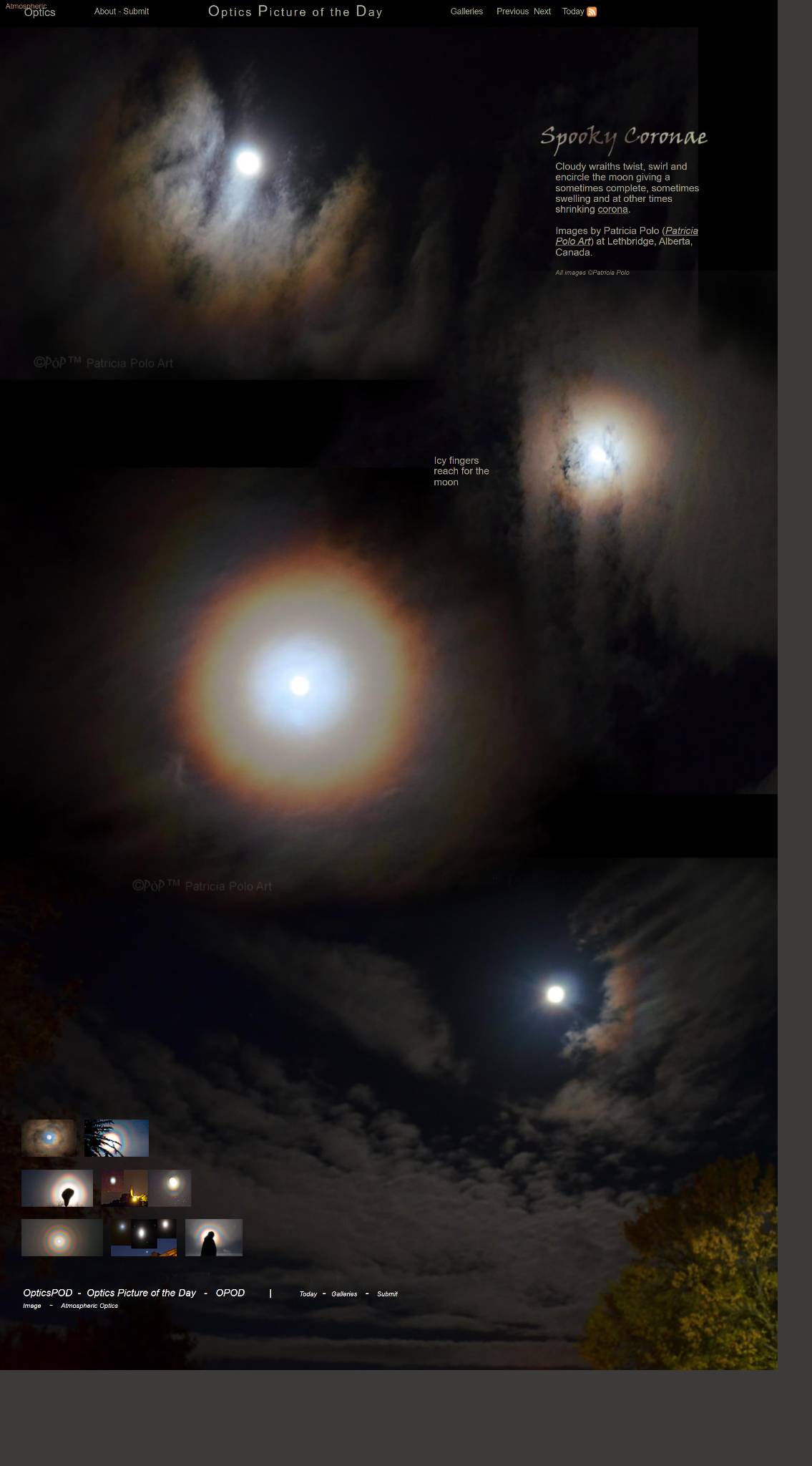Spooky corona - OPOD
Spooky Coronae: A Fascinating Atmospheric Phenomenon
Have you ever looked up at the night sky and noticed a ghostly, ethereal glow encircling the moon? This captivating optical phenomenon is known as a corona. The sight of these mysterious cloudy wraiths twisting and swirling around the lunar disk can be both mesmerizing and eerie. In this article, we will delve into the fascinating world of coronae and explore the science behind these spooky atmospheric optics.
Coronae are formed when light from the moon or the sun interacts with water droplets or ice crystals in the atmosphere. These tiny particles act as miniature prisms, bending and scattering the incoming light. The corona appears as a ring of colors around the celestial body, with the innermost region often displaying shades of blue or violet, followed by a series of pastel hues such as pink, yellow, and green.
The size and appearance of a corona can vary depending on several factors, including the size of the water droplets or ice crystals, their distribution in the atmosphere, and the angle at which the light passes through them. Under ideal conditions, coronae can exhibit a complete ring with well-defined colors. However, they can also appear irregularly shaped or fragmented, creating a more eerie and fragmented appearance.
One of the most captivating aspects of coronae is their dynamic nature. Unlike many other atmospheric phenomena that remain static, coronae can change in size, shape, and intensity within a matter of minutes. As clouds move and evolve, the water droplets or ice crystals responsible for forming the corona may disperse or cluster together, resulting in a constantly shifting display of colors and patterns. This fluidity adds to the mesmerizing and otherworldly allure of coronae.
Coronae are not limited to lunar displays; they can also be observed around other celestial bodies such as the sun. Solar coronae are particularly striking during total solar eclipses when the moon aligns perfectly with the sun, creating a breathtaking spectacle. The intricate details of the solar corona, with its delicate streamers and prominences, have fascinated astronomers for centuries.
To capture the beauty of coronae, many photographers use specialized techniques and equipment. By adjusting camera settings and employing creative compositions, photographers can enhance the ethereal qualities of these atmospheric phenomena. Patricia Polo, an artist based in Lethbridge, Alberta, Canada, has captured stunning images of coronae, showcasing their haunting beauty.
In conclusion, coronae are a captivating atmospheric optics phenomenon that adds a touch of mystique to our night skies. The interplay between light and water droplets or ice crystals creates a mesmerizing display of colors and patterns. Whether observed around the moon or the sun, coronae never fail to inspire awe and wonder. So next time you find yourself gazing at the night sky, keep an eye out for these spooky yet enchanting rings of light.

Spooky Coronae
Cloudy wraiths twist, swirl and encircle the moon giving a sometimes complete, sometimes swelling and at other times shrinking corona.
Images by Patricia Polo (Patricia Polo Art) at Lethbridge, Alberta, Canada.
All images ©Patricia Polo
Note: this article has been automatically converted from the old site and may not appear as intended. You can find the original article here.
Reference Atmospheric Optics
If you use any of the definitions, information, or data presented on Atmospheric Optics, please copy the link or reference below to properly credit us as the reference source. Thank you!
-
<a href="https://atoptics.co.uk/blog/spooky-corona-opod/">Spooky corona - OPOD</a>
-
"Spooky corona - OPOD". Atmospheric Optics. Accessed on November 26, 2024. https://atoptics.co.uk/blog/spooky-corona-opod/.
-
"Spooky corona - OPOD". Atmospheric Optics, https://atoptics.co.uk/blog/spooky-corona-opod/. Accessed 26 November, 2024
-
Spooky corona - OPOD. Atmospheric Optics. Retrieved from https://atoptics.co.uk/blog/spooky-corona-opod/.